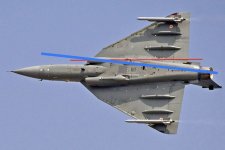View attachment 32876
This is called stealth inlet, India as long as from the oblique side can see the engine blade, I am afraid that only Indians will think he is invisible
You are free to believe what you want, but, even if that's the case, the LCA Mk1 has an RCS 3 times smaller than the M2000, which is already <1m2.
This is official data from the Swedish AF from early 2000s.
- Gripen's acceleration in sub-sonic and trans-sonic domains: faster than F/A-18C/D and M2000-5, but slower than F-16C.
- Gripen's instant turn rate: significantly better than F-16C, F/A-18C/D, and M2000-5.
- Gripenss sustained turn rate: worse than F-16C, F/A-18C/D, but better than M2000-5.
- The Gripen achieved the AoA of more than 100 degrees during the flight test, but due to the reason for flight safety, the normal setting of the upper limit of the AoA for the Gripen's FCS is 50 degrees now.
- Gripen's frontal RCS: about 1/5 of F/A-18C/D's, 1/3 of F-16C/D Block40/42's, and 1/2 of Mirage-2000-5's.
- Detective range of PS-05A radar (JAS-39): a little shorter than AN/APG-65/73 (F/A-18C/D), but 20% longer than RDY (M2000-5), and 40% longer than the AN/APG-68 for F-16C/D Block40/42.
- While combating with the basic type of MIG-29 (MIG-29G??) in BVR engagement:
- JAS-39A: the effective range for Gripen to detect MIG-29 is 60 km longer than the effective range for MIG-29 to detect Gripen.
- M2000-5: the effective range for Mirage to detect MIG-29 is 32 km longer than the effective range for MIG-29 to detect Mirage.
- F/A-18C/D: the effective range for Hornet to detect MIG-29 is 25 km longer than the effective range for MIG-29 to detect Hornet.
- F-16C/D: the effective range for Falcon to detect MIG-29 is 5 km longer than the effective range for MIG-29 to detect Falcon.
- Maintenance of GRIPEN:
- The MTBF for JAS-39A is 7.6 flight hours, and the SAAB declared that the MTBF for the USAF's frontline fighters (except F/A-22 perhaps) is no more than 4.1 flight hours.
- The man hours of maintenance for each flight-hour: 12 man-hours initially, than reduced to 10 man-hours (F/A-18 E/F: 15 man hours of maintenance for each flight-hour).
- The charge for each flight-hour: 2,500 USD initially, than reduced to 2,000 USD.
F/A-18 is 2 m2, F-16C is 1.2 m2, M2000 is 0.8 m2.
2/5 = 1.2/3 = 0.8/2 = 0.4 m2
LCA is 3 times smaller than M2000. So 0.8/3 = 0.267 m2.
95% of the LCA's surface area is composites. Although it wasn't designed for stealth, its still quite a small aircraft. So the combination of small size and composites has significantly reduced RCS compared to the all-metal Mirage. The LCA Mk1A will see further improvements in RCS.
We are being modest by saying LCA's RCS is 0.5 m2, but we know for sure it's better than Gripen C's 0.4 m2.
Aircraft like LCA, Rafale, Typhoon, Super Hornet and Gripen are called "reduced observable." Meaning, these are aircraft with RCS below 1m2.
The Koreans seem to have invented the term for the KF-21.

The Koreans have 4 categories.
MIN = Minimum Treatment. This is aircraft like the F-16C/E, J-10C, J-16, JF-17 B3, F-15EX, Su-35S, Su-30MKI, Mig-29M etc.
RO = 0.1 m2 class. Rafale, Typhoon, LCA, Gripen C/E, B-1B, Super Hornet etc. You can see some of these names in the image.
LO = 0.01m2 class. F-117.
VLO = 0.001m2 class.













